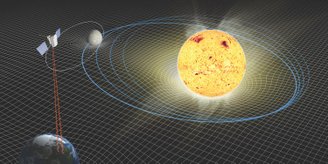One of humanity’s oldest dreams is to travel to the stars. Since ancient times we have longed to navigate the vastness of the Cosmos, set foot on other planets, and come into contact with other intelligent life forms in the Universe.
But these are as old as dreams these are the frustrations imposed by the harsh reality of our technological limitations and natural laws. It took Apollo astronauts more than three days to reach the Moon (the only manned mission to another celestial body up to that time).
If we move at the same speed, it will take more than a hundred thousand years to reach the Proxima Centauri system, the closest star to the Sun.
It is possible to imagine significant advances in drive technology that could increase this speed to a more robust rate. However, it will still be difficult for us to overcome thousands of years to complete this journey.
But remember this: This is true for the star closest to the Sun. So how can we consider traveling to more distant star systems or even other galaxies?
If you think a new Albert Einstein would be needed to develop such a method, you are dead wrong. In fact, it was the founder of the Theory of Relativity who first imagined the existence of space shortcuts that would make interstellar travel possible.

These shortcuts were called Einstein-Rosen bridges but became popular as wormholes. First proposed in a famous paper in 1935, Einstein and his assistant Nathan Rosen introduced an extreme limit to the standard approach to general relativity: As is well known today, clusters of matter and energy “weigh” the structure of space. it distorts it and causes other objects to fall into its path.
In other words, matter distorts the geometry of space-time, which guides the displacement of matter.
In search of a Theory of Everything that would model the entire Universe, including its content, Einstein sought mathematical solutions to the equations of general relativity that resembled particles. What he and Rosen discovered were bridge-like connections between different parts of the cosmic fabric.

But these bridges only began to be considered as a possible path to interstellar travel many years later, in the late 1980s, when physicist Kip Thorne began exploring the potential.
Thorne’s motivation came from a question from Carl Sagan: While working on his famous bestselling novel Contact, Sagan needed a plot that would allow for a quick and effective intergalactic journey.
He thought of Schwarzschild wormholes that form in black holes. but Thorne convinced him it wouldn’t work. Even if they were somehow stabilized, the connections of the black holes would crush the occupants and expose them to the rays.
After some time, Kip Thorne and his PhD student Chris Morris discovered a wormhole solution that had many positive properties: It allowed passage between two different parts of space through a kind of fixed “throat” that did not come into contact with each other. It collapsed as travelers passed by.
Travelers can: travel safely from one end to the other in a reasonable amount of time, less than a year. Sagan immediately incorporated Morris and Thorne’s plan into his plan.

The development of these wormhole solutions, even hypothetical solutions, has triggered many science fiction works and cultural artifacts about interstellar travel.
But as Morris and Thorne revealed and numerous subsequent studies confirm, Building wormholes will require a component not found in nature: It’s a matter of negative mass that will act as a stabilizing mechanism against gravity to help keep the wormhole entrance open.
Even if we found a significant amount of such exotic matter, a mass equivalent to millions of suns would be needed to build a wormhole to connect two different regions of the Universe.
Interstellar travel is completely out of the question at the moment, but perhaps one day this science fiction fantasy will become reality and the distant Cosmos will finally be within our reach.
Source: Tec Mundo
I’m Blaine Morgan, an experienced journalist and writer with over 8 years of experience in the tech industry. My expertise lies in writing about technology news and trends, covering everything from cutting-edge gadgets to emerging software developments. I’ve written for several leading publications including Gadget Onus where I am an author.













